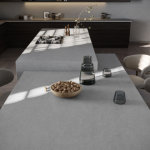Over 150 Years Of Local Manufacturing History | GH Commercial
GH Commercial benefits from a rich history of manufacturing experience in Australia and New Zealand, which spans over 150 years through the operations of Godfrey Hirst. The name Godfrey Hirst has long been associated with Geelong, dating back to 1865 when the Victorian Woollen and Cloth Manufacturing company was established, becoming one of Victoria’s pioneering textile mills.

GALLERY






Godfrey Hirst, an Englishman and the son of Charles Hirst, a spinner, began his career as a weaver in his family’s business. However, due to health reasons, he ventured to Victoria in search of a warmer climate. Initially, he worked as an insurance agent, but soon saw an opportunity to revive the struggling Victorian Woollen & Cloth Manufacturing Co. Despite the declining market and the company’s intention to rely on imports, Hirst firmly believed in the potential of local production, emphasizing the value of quality craftsmanship.

In 1888, Hirst embarked on his own business venture by renting a shed on Fyans Street. There, he resourcefully constructed his own loom using yarn provided by his former employers and the Albion mill to produce flannels. Despite the industry’s downturn, Hirst’s business thrived, prompting him to relocate to a larger premises in 1889.
In the pursuit of expansion and success, Hirst formed a partnership with Charles Shannon, a woolbroker, and Charles Smith, a fellmonger. Together, they acquired the derelict Barwon woollen factory in July 1890, renaming it the Excelsior Number One mill. Hirst took personal charge of raw materials and sales, and the workforce grew to about one hundred employees by 1895. In 1899, the company expanded further by acquiring and refurbishing the adjoining Victorian factory, known as the Excelsior Number Two mill.
With the advantages of interstate free trade following Federation and securing government contracts during World War I, the company’s payroll swelled to more than 300 in 1917. Godfrey Hirst & Co Pty Ltd, as the business was formally incorporated in October 1909 after the passing of Charles Smith in 1908, diversified its manufacturing to include blankets, rugs, tweeds, worsteds, and flannels. The company continued to flourish and adapt to changing market demands.

In 1911, and again in the aftermath of the fire that destroyed the Number One mill in March 1912, Hirst traveled back to England to seek the latest machinery for his business. Even while managing his ventures, he demonstrated a commitment to advancing textile education in Geelong by supporting the Gordon Technical College. His dedication to education was evident as he served as the college’s president from 1913 to 1916.
Beyond his business interests and involvement in education, Hirst had a diverse range of hobbies. He found enjoyment in spending leisure time at the Belmont and Corio clubs, as well as playing bowls. Moreover, Hirst had a profound passion for music and was a self-taught musician. He served as an organist at St. Georgie’s Presbyterian Church since 1889 and held the position of vice-president in the Geelong Musician Society. Additionally, he generously sponsored the Excelsior Mills choir and actively participated in the musical community at the Belmont Methodist Church.
Described as a man of strong principles and high expectations, Hirst remained somewhat reserved and lacked a certain common touch in his demeanor. He once attempted to join the South Barwon Shire Council but was unsuccessful in his bid. In 1908, he was appointed as a justice of the peace, further reflecting his commitment to serving the community and upholding the principles he held dear.

Hirst’s passing in 1917 marked the end of a remarkable life that had made a significant and powerful contribution to the revival of the woollen industry in Geelong during the early 1900s. After the death of Charles Shannon in 1922, Mrs. Hirst took charge and inaugurated a new dining hall. The company continued to grow, evident by the purchase of seven additional looms and other equipment in 1923.
Under the leadership of Willie Hirst, Godfrey Hirst & Co Pty Ltd carried on as carpet manufacturers. However, the family faced another unfortunate loss when Willie passed away in 1925. This led to Lewis Hirst taking on the role of Managing Director to keep the mills running smoothly.
In the following years, the baton of leadership was passed to Cedric Hirst, the grandson of Godfrey Hirst, who assumed control in 1951 after the passing of his father, Lewis Hirst. With a clear focus on carpet production rather than other textiles, the company continued to evolve and thrive.
Finally, in 1966, Godfrey Hirst Co was acquired, further solidifying its position in the carpet industry. Throughout its history, the company had endured both challenges and successes, leaving behind a lasting legacy in the Australian textile and manufacturing landscape.

In 2006, Godfrey Hirst & Co. Pty Ltd made a significant move by acquiring Feltex Carpets Limited, a publicly listed company in New Zealand. Feltex had a long history, having started its operations in New Zealand back in 1929, initially manufacturing felt slippers, and later expanding into carpet production during the 1940s.
The Australian operations of Feltex had been active since the 1920s and featured a diverse range of well-known brand names such as Feltex Reserve, Feltex Classic, Feltex Commercial, Feltex Woven, Invicta, Kensington, Redbook, Minster, and Tile modular carpet. Over the years, these brands had become reputable in the industry.
Beyond carpet manufacturing, the Feltex business in New Zealand also engaged in producing wool yarn and processing scoured wool for its own usage and other exporters.
Even after the acquisition, the Feltex name continues to exist as a heritage brand within the GH Commercial portfolio. Under this umbrella, Feltex offers a comprehensive range of products, including carpet tiles and planks, woven carpets, solution-dyed nylon carpets, and wool carpets. This extension of the GH Commercial portfolio further solidifies their position in the flooring market and allows them to cater to a wider range of customer preferences and needs.

In 2018, the Godfrey Hirst business was sold to Mohawk Industries, the world’s largest flooring company.
The acquisition also facilitated the introduction of the finest Mohawk commercial product offerings into the Australian market, further enhancing the range of options available to customers. Additionally, Mohawk’s European flooring business, Unilin, including the IVC Commercial brand, became part of the equation, adding even more diversity to the company’s portfolio.
To accommodate the growing portfolio of both local and global brands under its umbrella, GH Commercial was established in 2018. This new entity served as a home for the expanding array of flooring options and brands, consolidating Godfrey Hirst’s position as a prominent player in the flooring industry with a strong presence on the local and international stage.

As of 2023, both the residential Godfrey Hirst brand and the commercial GH Commercial brands have continued to thrive and strengthen their positions in the carpet and flooring industry. Their dedication to innovation and a customer-centric approach has been pivotal in their success. By closely listening to their customers’ needs and preferences, they have been able to deliver products and services that meet and exceed expectations.
The combined strengths of these two brands have solidified their position as a powerhouse in the carpet and flooring world. Their presence in the market remains strong, and their commitment to quality, durability, and style has earned them a loyal customer base. Whether in residential or commercial settings, Godfrey Hirst and GH Commercial have become go-to choices for customers seeking high-quality and reliable flooring solutions.
As they continue to grow, their focus on innovation and customer satisfaction ensures they remain at the forefront of the industry, setting trends and delivering top-notch products to meet the ever-changing demands of the market. The future looks promising for these brands as they continue to make significant strides in the carpet and flooring business.
For more information
Xeron® is Cosentino’s catalogue of zero crystalline silica* surfaces, made of up to 88% recycled materials, suitable to ...
Set in the heart of Melbourne’s inner eastern suburbs, this full-scale renovation redefines the connection between old and ...
Supported by the Australian Institute of Architects and attended by thousands of accredited architectural, design and building professionals, ...
In the world of interior and exterior architecture, few materials offer the visual allure and transformative qualities of ...
Perched atop a modernist monolith, a 19th-century Lorrain-style house appears to hover above the skyline of Metz, France. This ...








